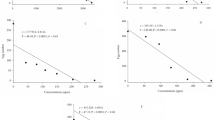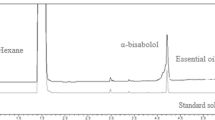Abstract
The western flower thrips (Frankliniella occidentalis Perg.) is one of the most economically important insect pests of greenhouse plants. Plant protection against this pest is based predominantly on synthetic insecticides; however, this form of protection poses problems in terms of thrip resistance to the active substances, along with health risks associated with insecticide residues on the treated plants. Therefore, new active substances need to be sought. Essential oils could be a new, appropriate, and safe alternative for greenhouse culture protection. As greenhouses are enclosed areas, fumigation application of EOs is possible. This paper presents acute toxicity results for 15 commercial EOs applied by fumigation, as well as the effect of sublethal concentrations on fertility of F. occidentalis females. The most efficient EOs were obtained from Mentha pulegium and Thymus mastichina, with LC50(90) estimated as 3.1(3.8) and 3.6 (4.6) mg L−1 air, respectively. As found for the very first time, sublethal concentrations of EOs could result in a significant reduction in the fertility of surviving T. occidentalis females. Among the tested EOs, the EO from Nepeta cataria provided the highest inhibition of fertility, with EC50(90) estimated as 0.18 (0.36) mg L−1 air. Chemical composition of the most efficient EOs and possible applications of the results in practice are discussed. In conclusion, in light of the newly determined facts, EOs can be recommended as active substances for botanical insecticides to be applied against Thysanopteran pests by fumigation.
Similar content being viewed by others
References
Abbott WS (1925) A method of computing the effectiveness of an insecticide. J Econ Entomol 18:265–267
Adams RP (2007) Identification of essential oil components by gas chromatography/mass spectroscopy. Allured Publishing Co., Carol Stream, IL
Benelli G, Pavela R (2018a) Beyond mosquitoes − essential oil toxicity and repellency against bloodsucking insects. Ind. Crops Prod 117:382–392
Benelli G, Pavela R (2018b) Repellence of essential oils and selected compounds against ticks – a systematic review. Acta Trop 179:47–54
Benelli G, Pavela R, Giordani C, Casettari L, Curzi G, Cappellacci L, Petrelli R, Maggi F (2018) Acute and sub-lethal toxicity of eight essential oils of commercial interest against the filariasis mosquito Culex quinquefasciatus and the housefly Musca domestica. Ind Crop Prod 112:668–680
Burt S (2004) Essential oils: their antibacterial properties and potential applications in foods-a review. Int J Food Microbiol 94:223–253
Cheng ZH, Duan HJ, Zhu XR, Fan FF, Li R, Li SC, Ma XY, Zhang EJ, Liu YK, Wang JY (2019) Effects of patchouli and wormwood oils on the bioassays and behaviors of Tetranychus cinnabarinus (Boisduval) (Acari: Tetranychidae). Inter J Pest Manag:1–8. https://doi.org/10.1080/09670874.2019.1636155
Childers CC (1997) Feeding and oviposition injuries to plants. In: Lewis T (ed) Thrips as Crop Pests. CAB International, Wallingford, UK, pp 505–537
Cloyd RA, Chiasson H (2007) Activity of an essential oil derived from Chenopodium ambrosioides on greenhouse insect pests. J Econ Entomol 100:459–466
Demirel N (2007) Attraction of color cups and plant compounds to thrips species on organic Napa cabbage. J Entomol 4:263–266
Enan EE (2001) Insecticidal activity of essential oils: octopaminergic sites of action. Comp Biochem Physiol 130C:320–325
Finney DJ (1971) Probit analysis. Cambridge University, London, pp 68–78
Gao Y, Leia Z, Reitz SR (2012) Western flower thrips resistance to insecticides: detection, mechanisms and management strategies. Pest Manag. Sci 68:1111–1121
Helyer N, Brown K, Cattlin ND (2003) Biological control in plant protection. Manson publishing, London
Ikbal C, Pavela R (2019) Essential oils as active ingredients of botanical insecticides against aphids. J Pest Sci 92:971–986
Isman MB (2015) A renaissance for botanical insecticides? Pest Manag. Sci 71:1587–1590
Jensen SE (2000) Insecticide resistance in the western flower thrips, Frankliniella occidentalis Integr. Pest Manage Rev 5:131–146
Jones DR (2005) Plant viruses transmitted by thrips. Eur J Plant Pathol 113:119–157
Katerinopoulos HE, Pagona G, Afratis A, Stratigakis N, Roditakis N (2005) Composition and insect attracting activity of the essential oil of Rosmarinus officinalis. J Chem Ecol 31:111–122
Kim KH, Yi CG, Ahn YJ, Kim SI, Lee SG, Kim JR (2015) Fumigant toxicity of basil oil compounds and related compounds to Thrips palmi and Orius strigicollis. Pest Manag Sci 71:1292–1296
Kirk WDJ, Terry LI (2003) The spread of the western flower thrips Frankliniella occidentalis (Pergande). Agric Forest Entomol 5:301–310
Koschier EH (2008) Essential oil compounds for thrips control - a review. Nat Prod Comm 3:1171–1182
Kostyukovsky M, Ravid U, Shaaya E (2002) The potential use of plant volatiles for the control of stored product insects and quarantine pests in cut flowers. Acta Horticulturae 576:347–358
Kostyukovsky M, Trostanetsky A, Quinn E (2016) Novel approaches for integrated grain storage management. Israel J Plant Sci 63:7–16. https://doi.org/10.1080/07929978.2016.1159410
Lee S, Peterson CJ, Coats JR (2003) Fumigation toxicity of monoterpenoids to several stored product insects. J Stored Prod Res 39:77–85
Machalova Z, Sajfrtova M, Pavela R, Topiar M (2015) Extraction of botanical pesticides from Pelargonium graveolens using supercritical carbon dioxide. Ind Crops Prod 67:310–317
Mejdoub K, Benomari FZ, Djabou N, Dib ME, Benyelles NG, Costa J, Muselli A (2019) Antifungal and insecticidal activities of essential oils of four Mentha species. Jundish J Nat Pharm Prod 14:e64165. https://doi.org/10.5812/jjnpp.64165
Morse JG, Hoddle MS (2006) Invasion biology of thrips. Annual Rev Entomol 51:67–89
Nuyttens D, Braekman P, Windey S, Sonck B (2009) Potential dermal pesticide exposure affected by greenhouse spray application technique. Pest Manag Sci 65:781–790
Pavela R (2007) Lethal and sublethal effects of thyme oil (Thymus vulgaris L.) on the House fly (Musca domestica Lin.). J Essent Oil Bear Pl 10:346–356
Pavela R (2008) Insecticidal properties of several essential oils on the house fly (Musca domestica L.). Phytot Res 22:274–278
Pavela R, Benelli G (2016) Essential oils as eco-friendly biopesticides? Challenges and constraints. Trends Plant Sci 21:1000–1007
Pavela R, Sedlák P (2018) Post-application temperature as a factor influencing the insecticidal activity of essential oil from Thymus vulgaris. Ind Crop Prod 113:46–49
Pavela R, Vrchotova N, Triska J (2009) Mosquitocidal activities of thyme oils (Thymus vulgaris L.) against Culex quinquefasciatus (Diptera: Culicidae). Parasit Res 105:1365–1370. https://doi.org/10.1007/s00436-009-1571-1
Pavela R, Stepanycheva E, Shchenikova A, Chermenskaya T, Petrova M (2016) Essential oils as prospective fumigants against Tetranychus urticae Koch. Ind Crop Prod 94:755–761. https://doi.org/10.1016/j.indcrop.2016.09.050
Pavela R, Maggi F, Iannarelli R, Benelli G (2019a) Plant extracts for developing mosquito larvicides: from laboratory to the field, with insights on the modes of action. Acta Tropica 193:236–271
Pavela R, Pavoni L, Bonacucina G, Cespi M, Kavallieratos NG, Cappellacci L, Petrelli R, Maggi F, Benelli G (2019b) Rationale for developing novel mosquito larvicides based on isofuranodiene microemulsions. J Pest Sci 92:909–921. https://doi.org/10.1007/s10340-018-01076-3
Rajendran S, Sriranjini V (2008) Plant products as fumigants for stored-product insect control. J Stored Prod Res 44:126–135. https://doi.org/10.1016/j.jspr.2007.08.003
Ribeiro NC, da Camara CAG, Melo JPR, de Moraes MM (2019) Acaricidal properties of essential oils from agro-industrial waste products from citric fruit against Tetranychus urticae. J Appl Entomol 143:731–743
Shaaya E, Kostjukovski M, Eilberg J, Sukprakarn C (1997) Plant oils as fumigants and contact insecticides for the control of stored-product insects. J Stored Prod Res 33:7–15
Teulon DAJ, Butler RC, James DE, Davidson MM (2007) Odour-baited traps influence thrips capture in proximal unbaited traps in the field. Entomol Experim Appl 123:253–262
Toumi K, Joly L, Vleminckx C, Schiffers B (2017) Risk assessment of florists exposed to pesticide residues through handling of flowers and preparing bouquets. Internat. J Environ Res Pub Health 14:526. https://doi.org/10.3390/ijerph14050526
Wagan TA, Cai WL, Hua HX (2018) Repellency, toxicity, and anti-oviposition of essential oil of Gardenia jasminoides and its four major chemical components against whiteflies and mites. Sci Reports 8:9375. https://doi.org/10.1038/s41598-018-27366-5
Yi CG, Choi BR, Park HM, Park CG, Ahn YJ (2006) Fumigant toxicity of plant essential oils to Thrips palmi (Thysanoptera: Thripidae) and Orius strigicollis (Heteroptera: Anthocoridae). J Econ Entomol 99:1733–1738
Zhang ZL, Xie YJ, Wang Y, Lin ZF, Wang LH, Li GY (2017) Toxicities of monoterpenes against housefly, Musca domestica L. (Diptera: Muscidae). Environ Sci Pollut Res 24:24708–24713. https://doi.org/10.1007/s11356-017-0219-4
Funding
Financial support for the botanical pesticide and basic substance research was provided by the Ministry of Agriculture of the CR (Project No. QK1910103)
Author information
Authors and Affiliations
Corresponding author
Ethics declarations
Conflict of interest
The authors declare that they have no conflict of interest.
Additional information
Responsible editor: Philippe Garrigues
Publisher’s note
Springer Nature remains neutral with regard to jurisdictional claims in published maps and institutional affiliations.
Rights and permissions
About this article
Cite this article
Stepanycheva, E., Petrova, M., Chermenskaya, T. et al. Fumigant effect of essential oils on mortality and fertility of thrips Frankliniella occidentalis Perg. Environ Sci Pollut Res 26, 30885–30892 (2019). https://doi.org/10.1007/s11356-019-06239-y
Received:
Accepted:
Published:
Issue Date:
DOI: https://doi.org/10.1007/s11356-019-06239-y




